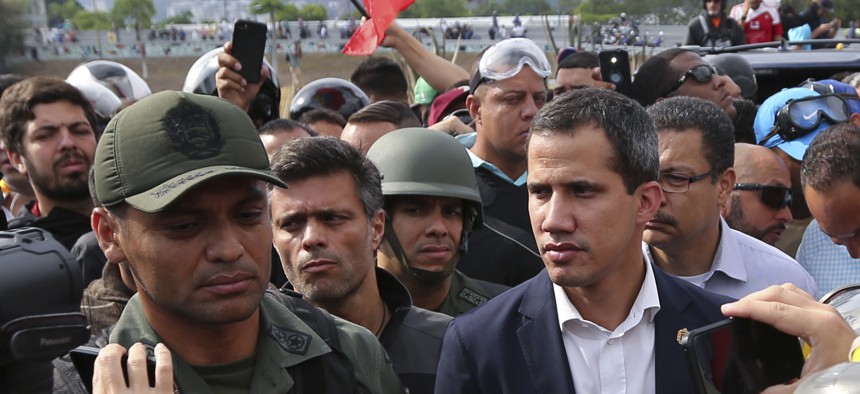
Venezuela's opposition leader Juan Guaidó, center right, flanked by activist Leopoldo López, center left, stands with National Guard Lieutenant Colonel Ilich Sanchez, outside La Carlota air base in Caracas, Venezuela, Tuesday, April 30, 2019. AP Photo / Fernando Llano
Maduro’s Media Crackdown Fails as Protests Overwhelm Caracas
The blue armband uprising of Venezuelan soldiers shows that viral messaging remains the future of protest.
Tuesday's escalation in violence in Caracas is a sign that Venezuelan President Nicolás Maduro’s efforts to suffocate his opposition and their protests via information backout have not worked as planned.
As the protest began to unfold, the regime shut down aspects of public transportation to keep people from the protests in the capital. But footage showed thousands of protestors taking part anyway. Maduro then blocked access to social media sites and search engines and, eventually, entire international news networks including CNN and the BBC. The regime ordered radio stations to cease broadcast on what supporters are calling “operation libertad.”
Yes, word quickly spread around the world anyway.
Government-ordered information control in Venezuela is not new. In 2004, Venezuela passed the Law on Social Responsibility in Radio and Television act that allowed the regime of late President Hugo Chávez wide latitude in censoring media, which was a response to a 2002 coup attempt Chavez blamed, in part, on the press.
The spread of social networking gave the government a different threat to contend with, and so in 2011, they expanded the law to include social networks and the broader Internet.
Since then, information blackouts in Venezuela have varied from bad to worse. Following the widely disputed 2018 elections, when Maduro claimed victory for a second term, the information space in Venezuela has been particularly stormy. Opposition leader Juan Guaidó’s speeches have been blocked from viewership by CANTV, the state-run internet and telephone provider. More than 40 journalists have been detained, including Univision's Jorge Ramos. They even blocked access to view a Live Aid-style concert for Venezuela playing on YouTube.
There are tricks to beat the regime. Some in Venezuela get around government information blockaides through the use of WhatsApp as well as virtual private networks, or VPNs, that allow them to download other specialized communication apps, or just access the Internet as though they were in another country. But it's been hard to tell how well or how quickly anti-government messaging can spread among the Venezuelan populace and beyond.
A real test came Tuesday morning when Guaidó released a video on his Instagram channel calling on the Venezuelan military to support his efforts to oust the Maduro regime and calling for people around the country to join in protest.
“People of Venezuela, let's take to the streets... to support the end of the usurpation, which is irreversible... The National Armed Forces have taken the correct decision, they have the support of the people of Venezuela, and the backing of our constitution, they are guaranteed to be on the right side of history,” Guaidó says in the video.
The Guaidó camp has been pushing the narrative that the rank-and-file military is behind them, a claim supported previously by video footage of soldiers who defected, pledging their allegiance to the opposition. By day’s end, two dozen others had requested asylum at the Brazilian embassy in Caracas, CNN reported. For the Maduro regime, small numbers of defections posed a manageable threat. But today, following the release of Guaidó’s call to the streets, video surfaced of Venezuelan military personnel donning blue arm bands and bracelets to illustrate their allegiance with rebel factions. More footage shows the blue-arm banded rebels providing armed escort to protestors, soldiers actively confronting other soldiers in the streets, as well as of opposition leader Leopoldo López, of Guaidó’s Popular Will party, marching toward the presidential palace surrounded by men in military uniform. López was under house arrest until very recently. The message from the opposition was clear: we can organize, seize the world’s attention, grab and hold the narrative, and we are more numerous than you realize. It was a success not only in viral messaging (a short, improvised video picked up by media outlets around the world and watched more than one million times on Guaidó’s Instagram channel) but also in executing months of secret plans in a particularly repressive communications environment.
The Maduro regime acknowledged during the day that some members of the military were in active revolt, and that they are facing a coup, one that Defense Minister Vladimir Padrino described as “partially defeated.”
"The weapons of the republic are here to defend the nation's sovereignty and independence," Padrino warned.
After nightfall, Maduro went on his own information counterattack in a televised address to the nation, declaring victory on the day. “I want to congratulate you for the firm, loyal and courageous attitude with which you have led the defeat of the small group that tried to fill Venezuela with violence,” he said.
Maduro’s options are rapidly winnowing. He can use greater military force against the protestors and internationally-backed Guaidó, or he can take no action as the protests grow. Either way, trying to block information access to convince the world, and Venezuelans, that the protests aren’t happening is no longer a viable option.
NEXT STORY: Here's the US Navy’s Drone Tanker, on the Road





